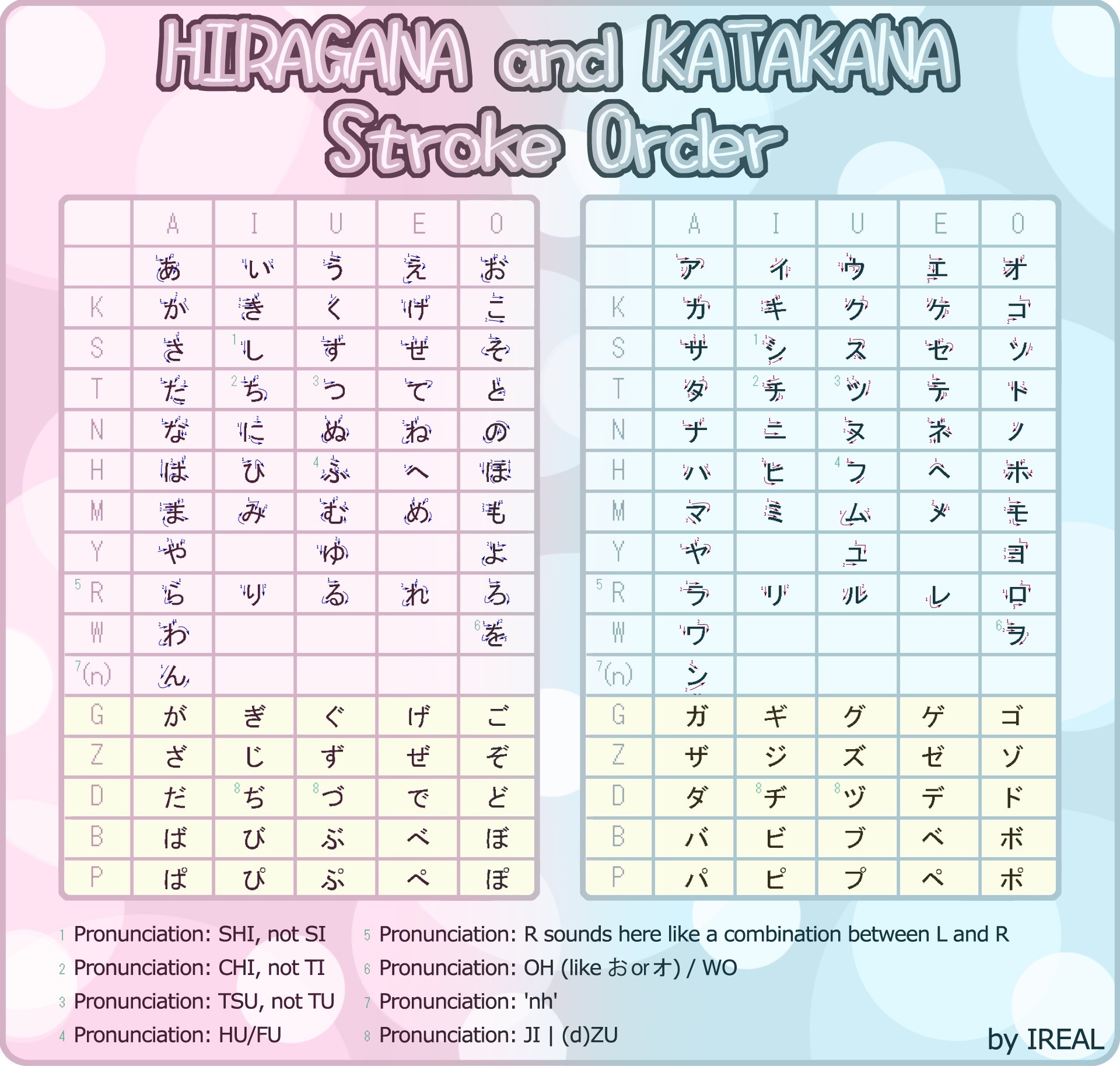Japanese Guide¶
I know that the following guide is long. But language learning is something you do in the long term, so please take time to read this guide in its entirety.
New: 30 day routine to learn Japanese from scratch: UsagiSpoon
Why many people “fail” to learn Japanese¶
Before I talk about this, I would like to clarify what I mean by “fail”. What I mean is, not being able to achieve their goals. Many people love the idea of being fluent, and being able to watch Japanese media without subtitles, in their raw form. However, many people also don’t ever reach this goal, or even get close. I believe it mostly isn’t their fault, but rather, the method’s fault.
Whether you’re a “visual learner” or an “auditory learner” does not mean anything when it comes to learning a language, you have a big problem if you acquired your first language by hearing it (like we all did) but apparently you’re more of a “visual learner.” It mostly comes down to the method used to study Japanese. There are other factors too, such as motivation, or hours spent each day/consistency. But I believe the method in the first place is very important.
For example, if someone told you that you could learn to swim by reading a book about swimming, would you be able to swim after you finished that book? No. That is because this is a fundamentally flawed method - it does not work.
What this guide aims to do is educate you on effective methods to study Japanese, so that you don’t end up like the others that failed and instead succeed, all while having fun in your target language, and in this case, your target language is most likely Japanese. Back to the “visual learner” and “auditory learner” thing, while it may be true for other fields of study, it is not valid for acquiring a language. We all acquire language in the same exact way, and that is through comprehensible input. I often come across people saying, “everyone learns differently” and again, this may be true for other fields of study but not for language acquisition. Key word: acquisition.
Learning vs. Acquisition¶
Learning a language properly refers to a conscious process, similar to what one experiences in school. The individual is given “grammar rules” and/or a “vocabulary list” to remember. When it comes to communicating in the language, they recall these rules and vocab they have learned and try to use that to speak the language. According to Stephen Krashen, the leading linguist in language acquisition, this is less effective than acquisition.
Acquisition of language is a natural, intuitive, and subconscious process of which individuals need not be aware.
What this actually means is, this process is fundamentally the same for everyone, hence natural and acquired pieces of language can be utilized intuitively, where the individual, in opposition to learning, does not need time to think and form sentences using learned grammar and vocabulary. And finally, subconscious means that the individual is unaware that the process is happening; the acquisition process may not feel like “language learning” and when new knowledge is acquired, the acquirer does not feel like they have learned anything.
Acquisition requires meaningful interaction with the target language, during which the acquirer is focused on meaning rather than form. What this means is, one is not concerned with the form of the language they are hearing and/or their utterances but with the messages they are conveying and understanding.
※ “Learning Japanese” may improperly refer to both acquiring and learning. So please keep that in mind.
i+1¶
From Wikipedia: “[The Input Hypothesis] states that learners progress in their knowledge of the language when they comprehend language input that is slightly more advanced than their current level. Krashen called this level of input “i+1”, where “i” is the learner’s interlanguage and “+1″ is the next stage of language acquisition.”
In simple terms, i+1 means “one [and no more than one] thing [piece of language] you do not yet know in the sentence" Say if you were learning English and you heard the sentence, "I'm playing the guitar", but you didn't know the word "playing" . This sentence would be i+1 because you know all the words and grammar structures apart from "playing". This is also comprehensible input IF you understood the message it was conveying.
i+1 is important because the highest level of acquisition gains are obtained at this level.

Input & Comprehensible Input¶
Input itself refers to listening and reading to native content in the target language. Mass input can be referred to as immersion. Native content means content made by natives, for natives. (Raw) Anime is made by natives, for natives, therefore it is native content. Comprehensible input refers to input where messages are conveyed and understood. It is the most crucial ingredient in the acquisition of language. Any input is not sufficient for acquisition, the input must be comprehensible.
However, as a beginner, it may seem difficult to find comprehensible input, and that is true. I will touch later on how you can benefit from incomprehensible input, too, but not in the same way. Language is not acquired from incomprehensible input but from comprehensible input. So please keep that in mind.
It is also important to keep in mind that talking (output) is not practicing a language. When people give anecdotes of how they got better at a language by speaking a lot, they do not realise that it was the input (from the partner) which improved their skill at the language.
Speaking (output) is just the icing on the cake, and input is where you are actually acquiring language.
Knowing whose advice to trust¶
It may seem natural to take as much people’s advice as you can, after all, they have experience right? Maybe you can learn something valuable? Well, not quite. If the person you are taking advice from has not achieved what you want to achieve, then you have no reason to trust their advice. If you do, then you will get no better than the low level they are at right now.
As a beginner, you have no way to properly judge someone’s language ability, as your linguistic competence of the language is very low, or virtually non existent, therefore you are no one to judge if your friend is really good at Japanese or not.
Why is this important? Because I often come across people that say things like “But my friend that learns Japanese told me that…” and the thing that the friend told the other friend is usually pretty misguided and blatantly false.
Has your friend achieved something close to what you want to achieve? If not, you do not have much luck getting past the low level they are at if you follow their advice. It would be like taking dieting advice from someone that's fat.
”Learning” Japanese Effectively¶
Now that you know the basics of language acquisition, let’s dive into how to learn Japanese.
Kana¶
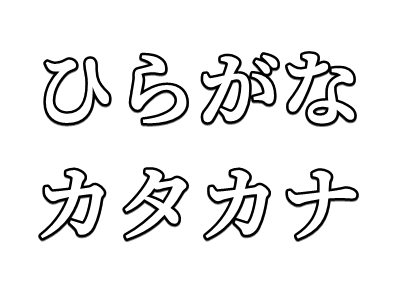
Kana refers to hiragana and katakana, they are the two scripts of the Japanese language. Hiragana and Katakana are two versions of the same sounds in the language.
Hiragana is used for words and names not written in kanji and for grammatical purposes. The writer can choose whether or not to use the kanji form. Katakana is used for words borrowed from other languages and foreign names, it can also be used for emphasis, however, the usages of hiragana and katakana are not always consistent, so take note of that. The kana is not hard to master and therefore I’d say, learn it however you want. It’s better if you have audio with it, too. Mnemonics may seem like a good idea, but I’ve seen people complain that it makes the process of recalling the kana slower, so I’d say just brute force it.
You need to learn this first.
I recommend you read Tae Kim and pause after The Writing System. This is to dispell any misconceptions you may have about kana, so you know exactly what they are and how they are used at first hand.
After that you should copy out the chart below in a notebook or something similar. You may never need to use a pen ever again after this.
The Chart:
When you've done that you should go on DJT Kana and check all the kana by going in "show/hide" and test yourself. Make sure you also scroll down and check all for hiragana combinations and katakana/katakana combinations!
Steps if you got confused:
- Read Tae Kim until you complete The Writing System
- Copy out the chart above into a notebook or something similar.
- Test yourself by using DJT Kana. Make sure you check all the kana by going in "show/hide" and test yourself. MAKE SURE you also scroll down and check all for hiragana combinations and katakana/katakana combinations!
After a week or so, you should have all the kana nailed down.
Kanji¶
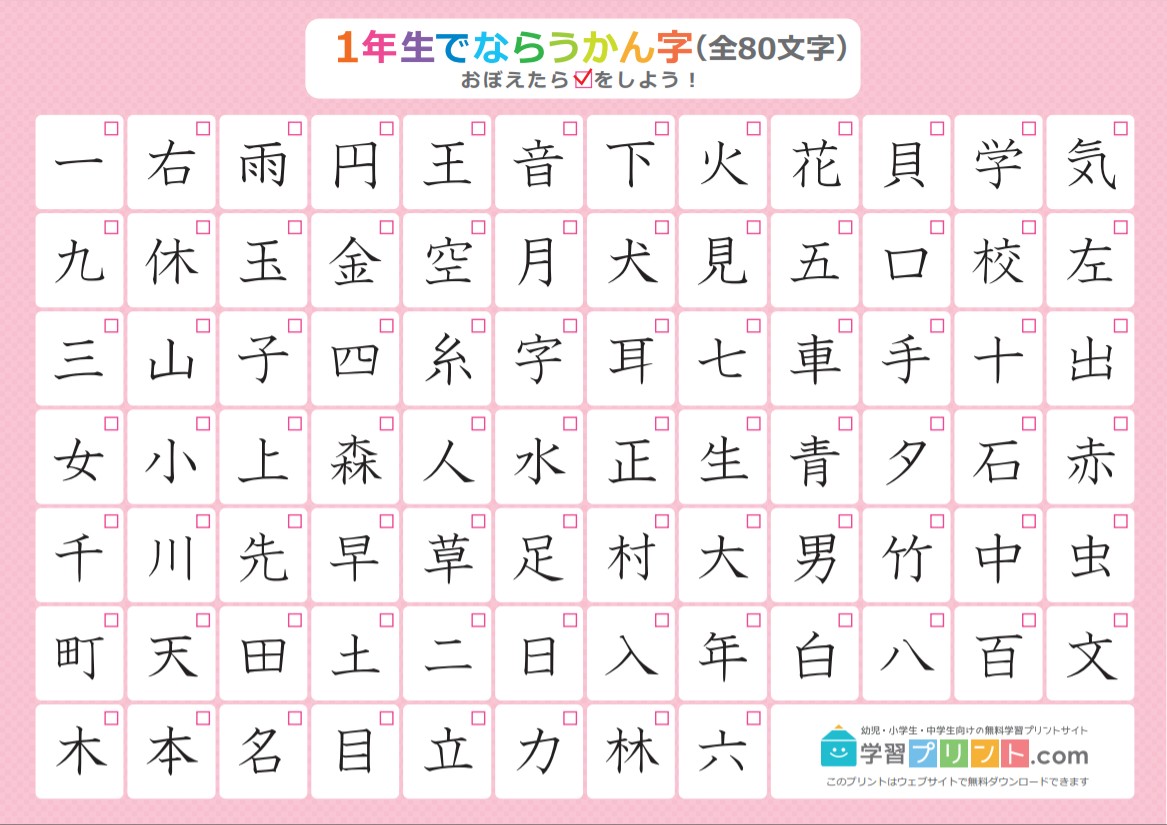
Kanji, literally meaning "Chinese Characters" is the third part of the Japanese writing system. They are logographic and therefore much more complex than kana. There are 2136 kanji taught in the Japanese school system, however don’t let this fool you.
Around 3000 or more are used in daily life. Kanji are used when they are used. You will eventually understand what this means when you get a little more advanced in Japanese.
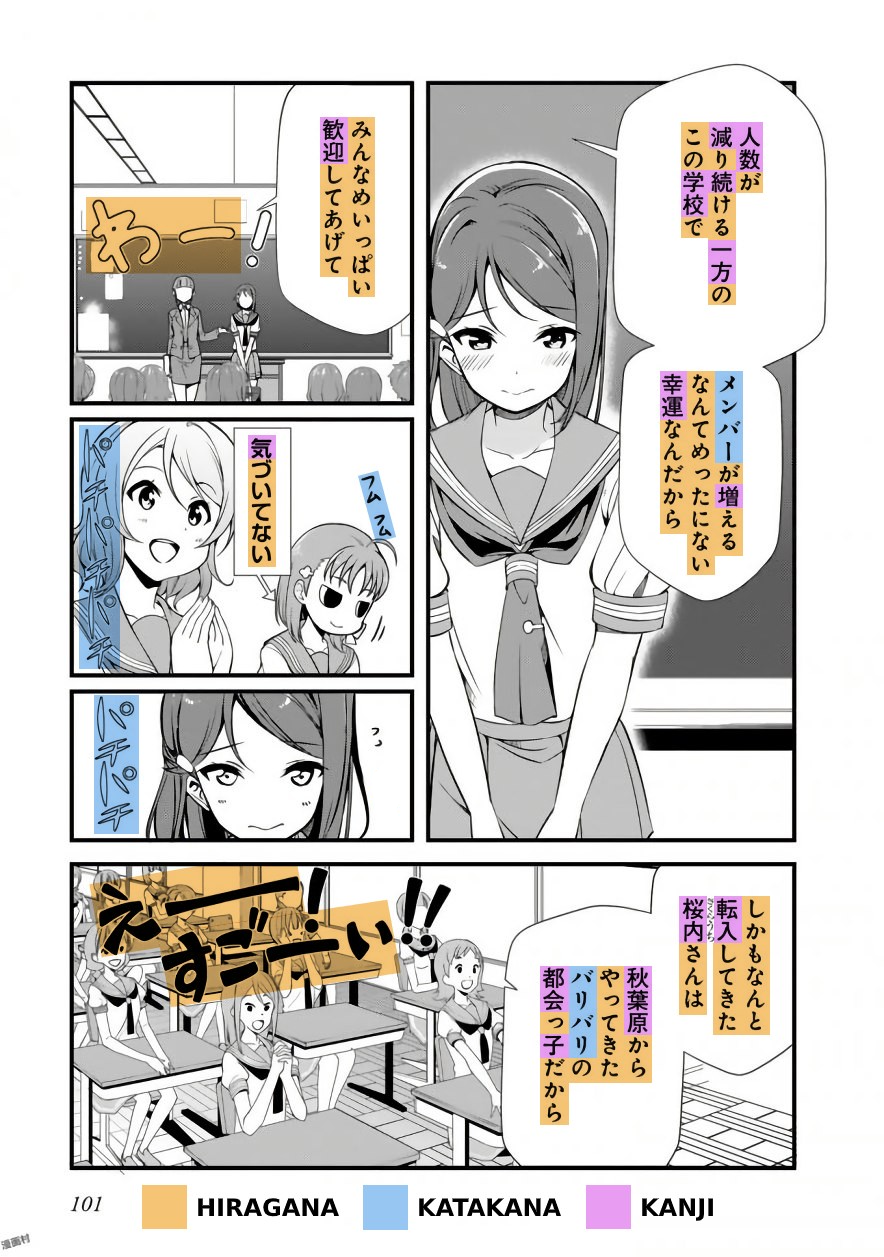
Above is a page from the Love Live! Sunshine!! manga, showing hiragana, katakana and kanji.
Approaching Kanji - Kanji With Vocab vs. Isolated Kanji Study
There’s two ways to approach kanji. One is kanji with vocab which is to learn words from reading without studying the individual kanji. You can fully comprehend "守銭奴" without knowing what the individual kanji mean just by looking it up in a dictionary.
The other is isolated kanji study which is studying the meaning and composition of the individual kanji. Example: "守"(guard)"銭"(coin)"奴"(guy) = cheapskate. Huh? It’s pretty smart. Isolated kanji study can make remembering vocab easier, but it can put you behind due to the amount of time it takes, so it is up to you to decide whether it is worth it.
※ Another interesting thing about kanji with vocab, is that if you know other words that also use the kanji of said word, it can become easier to remember. (Example: If you can comprehend "守護", "銭湯" and "売国奴" then "守銭奴" becomes easier)
How to: Kanji with Vocab
This is the most simplest approach to kanji, and it is the approach I took personally. Most people will be able to read kana just by referring to the kana chart, but you can’t do the same for kanji. So how do you learn to read kanji?
Look at the manga picture above. Look at the first panel. You see "人数"? That’s a word. Look it up in a dictionary such as Jisho. You get the reading: "にんずう (ninzuu)" and the meaning: "number of people". Cool, move on. That’s it. But don’t expect to remember words just by looking it up once, that is why you should read a lot to build up and retain kanji skill. At the end of the guide I will go through how to make the process of looking up words easier.
How to: Isolated Kanji Study

When approaching kanji as a beginner, they can look like scribbles rather than familiar shapes. Kanji have common shapes and patterns and Isolated Kanji Study helps you see those common shapes and patterns. Instead of "草" looking like a random drawing, you can see that it’s composed from "艹", "日" and "十".
An isolated kanji study method I recommend is Kodansha kanji learner's course (KKLC), you can get the book here and a study guide here. Don't learn the vocabulary in the book! Only learn vocabulary as described in the Vocabulary and Mining sections.
With that said, by reading and looking up words for hours and hours on end, you will learn how to recognize kanji intuitively, however many people may struggle to read Japanese kanji without prior study, and isolated kanji study might help you in this case, as it gives you a hint of what the kanji means beforehand. However isolated kanji study is a significant time investment that does not contribute to knowing Japanese in any meaningful way, and to truly "learn kanji" you need to do kanji with vocab anyway. You should decide by yourself whether or not you want to do isolated kanji study.
Vocabulary¶
The bulk of your language learning journey is learning vocabulary, so you will be doing a lot of it.
Anki is a spaced repetition system (SRS) flashcard program. It is designed to help you remember information. You can get it here
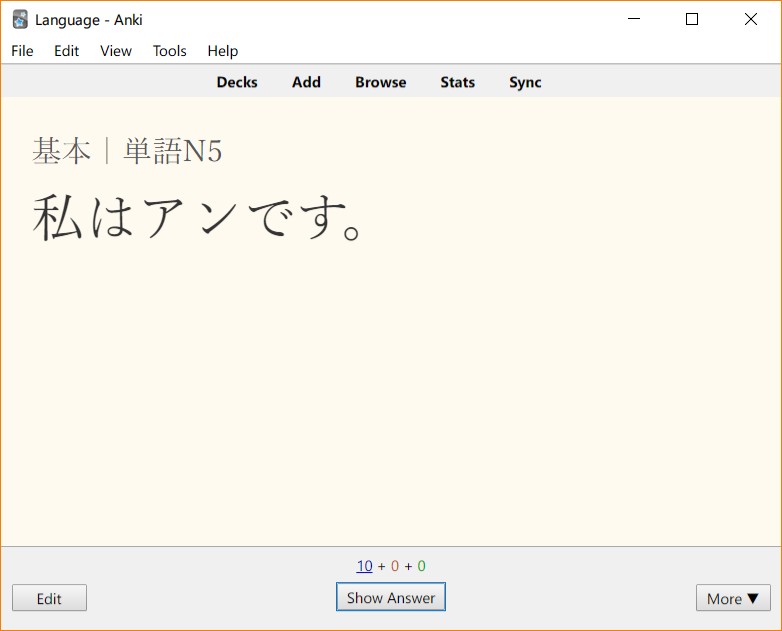
You should use Anki to build up a vocabulary of basic words to assist your immersion, after that learning vocabulary from immersion, especially in reading, becomes easier. Usually people use the Core 2K deck to build up a vocabulary of 2000 words. It works by showing you the word you need to learn at the front, and it has the meaning and how to read it at the back, along with a voiced example sentence. You learn words with Core2K by recalling the meaning and reading of the displayed word. However, I advise against using Core 2K, and suggest you do Tango N5+N4 instead, and here’s why:
Core 2K is significantly harder than Tango N5+N4 because Tango has the sentence on the front, Core 2K has only the word on the front.
Tango decks work by showing you a sentence at the front, and the piece of information (a meaning and reading) needed to understand the sentence at the back. You click "Good" whenever you understood the sentence, and "Again" when you did not.
The "N" number in the deck name refers to the Japanese Language Proficiency Test (JLPT), with N5 being the lowest, easiest and N1 being the highest.
Sentences make recalling vocabulary easier, after all, it is much more close to how we use language in real life as opposed to isolated words.
However, it is important to note that Tango's translations are not literal, and do not represent Japanese structure well, so I guess that's a flaw of Tango. In other cases, it might be utterly wrong.
People have always struggled with Core 2K, and to make the process smoother, I recommend Tango N5+N4 over Core 2K. Especially if you don’t want to do isolated kanji study!
I recommend you start learning vocabulary using Anki after you have learned the kana and know extremely basic grammar. How basic is extremely basic is up to you to decide. I will go through how to study grammar after this section, so don't panic.
Grammar¶
When approaching grammar, it is important to know that the purpose of a grammar guide is not to make you a master at the language, but to give you only a basic understanding of how things work in the language, and then a true understanding of grammar can only be achieved through immersion. Therefore, I recommend you choose a grammar guide, read/watch it and do immersion.
Choosing a grammar guide
There are many grammar guides out there, some are good, but some are bad. To prevent confusion amongst learners, i will only mention 2 grammar guides. Tae Kim and Cure Dolly. No grammar guide is perfect, they each have their ups and downs. Tae Kim is written pretty well, and very beginner friendly, however some of his explanations may be a little off and it can get boring to read. Cure Dolly takes an unorthodox approach to Japanese grammar, trying to teach Japanese grammar in a more Japanese “organic” way. However, Cure Dolly is not the most absolute beginner friendly, you need at least some background knowledge before using. Also, the audio is very poor.
You can find the 2 grammar guides below:
Tae Kim
There is also an Android and iOS app for offline viewing!, note that everything in this guide is considered to be "basic Japanese", even the “advanced” section
Cure Dolly
I recommend turning on subtitles and setting the speed to 1.25x!
With that said, I suggest doing grammar study in conjunction with your immersion and vocabulary study.
Mining¶
Mining means when you add vocabulary (often along with the sentence they were found in) into your Anki deck. You can then review these flashcards overtime to make sure you don’t forget them. It usually recommended you begin mining right after you finished Tango N5+N4. You should not bother with Tango N3, N2 and/or N1 because at this point you should be making your own flashcards from your immersion, which is overall a fun process.
Mining is something you will be doing for a long time, so this is pretty important.
There’s a lot of disagreement when it comes to “formats” of mining, but I think the "Anime cards" format is very good, and has served me really well.
Animecards Vocab Cards
Animecards are High Quality vocab cards which are different to standard vocab cards. Standard vocab cards simply have the word in kanji form on the front, and the reading and meaning of that word at the back. High quality vocab cards, as opposed to standard vocab cards, have the audio of the sentence (from an anime or voiced Visual Novel), also a picture (from an anime or Visual Novel) and the sentence it came from at the back, making them much more superior to standard vocab cards.
I think it is good to graduate sentence cards after you finish Tango N5 and N4 (Tango decks are sentence cards by the way), as vocabulary cards become easy and quick as you have familiarzied yourself with simple Japanese.
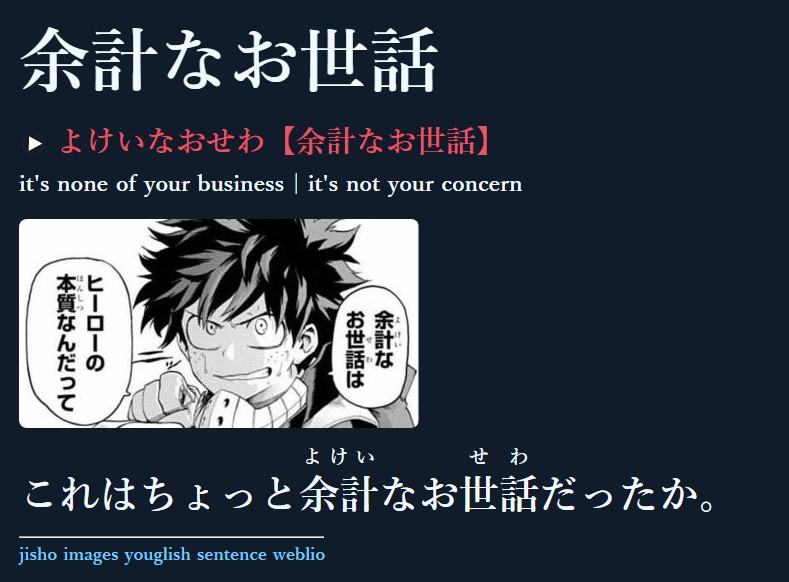
※ They are known as “Anime Cards” because of AnimeCards Site
Benefits
+ Easy to set up
+ Quick to review. I average 500 cards in 30 minutes with these.
+ Able to mine everything and anything (does not follow i+1)
+ Compensates for words with multiple meanings with the hint field.
After you have finished the Tango N5 and N4 decks, you should read this site AnimeCards Site to learn how to set up a mining deck.
How to Immerse (inputting)¶
What you need to do when immersing is different depending on what stage you are on. This is why making a one size fits all Japanese guide is difficult. I will only go through what you need to do as a beginner.
Listening¶
First of all, when it comes to immersing, you must learn to tolerate the ambiguity. The point is not to understand everything. It is not uncommon for learners to feel down over not understanding anything but I think it is totally fine not understanding, you should make merry every word you recognize, every little bit you do understand and just because you don't understand now, that doesn't mean you will not always not understand. The most important part of learning Japanese is enjoying yourself 
When you are a beginner, I recommend doing listening immersion over reading immersion. This is because when you first approach a foreign language, you are not yet used to the phonemes (sounds) of the language, so reading may give you a poor accent, this is when you associate similar, yet wrong phonemes from your native language to Japanese, it is impossible to read without mapping some phonetic component, so you can only avoid this by first getting used to the phonemes and you can only do this by doing raw listening.
Furthermore, listening just flows without stopping, so you feel more comfortable when immersing. On the other hand, reading as a beginner is very frustrating as you need to constantly look up words probably every second.
Surprisingly, there are many i+1 opportunities in listening immersion as a beginner, especially when you are studying grammar and vocabulary alongside your immersion, so it still passes as comprehensible input, even if you don’t understand other parts. But language is not acquired through incomprehensible input remember? That is true, however, you are still benefiting from incomprehensible input but in a different way; it is improving your ability to distinguish phonemes, in other words giving you a better accent. Immersing even if you don’t understand much is also a great way to build up a habit of interacting with your Japanese.
With that said though, immersion (input) at this stage will still be largely incomprehensible, however you can change that by working through the Tango Anki decks.
Please note that you need to pay attention to your immersion. (Active Immersion).
Just putting it on in the background and not paying attention (Passive Immersion) is not going to help you.
Choosing what to immerse with
It’s usually best to immerse with something with a visual and audio component, such as anime and j-drama (TV Show). TV shows have a visual component, and also a plot, so this brings more i+1 opportunities. It is not recommended to immerse with say, a podcast or an audiobook as a beginner, as it will be difficult to perceive what is going on. If you are learning Japanese, then chances are you are a fan of anime so you can use that to immerse, and even anime you have seen in the past.
What is also pretty helpful is reading an episode summary of the episode on Wikipedia before watching it, this can help you understand the plot more, so you can make more acquisition gains.
What do I need to be “doing” while actively immersing? (As a beginner)
Try to understand messages. There is a lot you can infer from a TV show. Like Krashen says, you need to have “meaningful” (meaning focused) interaction with the language, rather than focusing on form (such as grammar).
Reading¶
Reading, no matter what stage you are at, can benefit you greatly. However, as a newbie to the language, there are a few problems that arise when it comes to reading early on in the process.
Reading early can have a bad effect on your accent. And your reading ability may not always transfer (being able to hear the new words you learned) to your listening ability, especially if your listening ability is considerably low.
When you’re a beginner, I recommend watching Japanese subtitled anime for reading practice. Japanese subtitles are reading immersion at best, similar to a voiced visual novel. Having the voices in the background isn’t going to save your accent nor improve your listening skill, you need to do raw listening. You can see animecards.site to learn how to watch anime with Japanese subtitles.
Anyway, I think it is good to start out with Japanese subtitles for reading. And transition to manga, and then light novels/visual novels and so on. I think it is important you pace yourself when reading and don’t burn out trying to read hard novels as a beginner, it is usually better reading books that are not too far off from your level.
In our Resources you can find links to sites that let you read a lot of Japanese manga and novels, for free. And Japanese subtitles too, so make sure you check that out!
Finding the balance between listening and reading
Balance is important. It may be obvious just to split your time up in half, and if you are able to do that, then that is great. However, not everyone has the time, and when it comes to reading, depending on your current level, it may be considerably difficult to read for extended hours. For example people that have gotten further in the Tango Anki deck may be able to read longer than those who are a little behind.
So what is the perfect balance?
I cannot answer that, that is up to you to experiment and decide. It all depends on your schedule and current level. You don’t need to do reading from day 1, give it a few weeks until you can read basic words from the Tango N5 Anki deck.
Summary¶
- Learn the kana and start learning from your chosen grammar guide.
- Download and setup Anki. Import the Tango N5 deck by clicking on it.
- Click the cog icon next to the deck > Options. The default limit of new cards per day is set at 20. Try to stick with this number for a few days and see how it goes for you, if you feel like it is too much, then you can lower the limit to 15 or even 10. Check in the “Reviews” tab, set the Maximum reviews/day to 9999. Don’t be startled by this number. It will likely not go over 150 with okay retention rate. If you fail to keep up with the reviews you are getting, lower your new cards/day instead of lowering the maximum reviews. This is because not doing your due reviews interferes with Anki’s spaced repetition system. Anki requires consistency in the long term for it to be effective, try creating a schedule for it. Personally I do my Anki when I wake up in the morning.
- Do Anki daily, while also doing your chosen grammar guide and immersing daily.
- Repeat until you have finished Tango N5, now you should do Tango N4. You should feel more comfortable with reading now, I suggest you start reading easy manga or watch anime with Japanese subtitles.
- After you've finished Tango N4, set up your mining deck, watch whatever you like, read whatever you like and HAVE FUN!!
Final Notes¶
That’s it. You can get fluent in Japanese just like that. But don’t forget that the most important part is immersion, Anki and grammar only assist your immersion.
Music is not immersion.
However, you can use the lyric sheet as reading practice.
This guide would have not been possible if it was not for Stephen Krashen, Mass Immersion Approach, All Japanese All The Time, AntiMoon, Daily Japanese Thread/Itazuraneko, and my brothers and sisters here in TheMoeWay. Thank you all!
Note
You should not expect to comprehend this guide the first time you read it. Take your time and read it as many times as you can until you finally get it.
Further Reading¶
Input Hypothesis
Spaced Repetition
All Japanese All The Time
AntiMoon
Itazuraneko (clean mirror)
Found this useful? Consider supporting me on Patreon!
Are you using the right font?¶
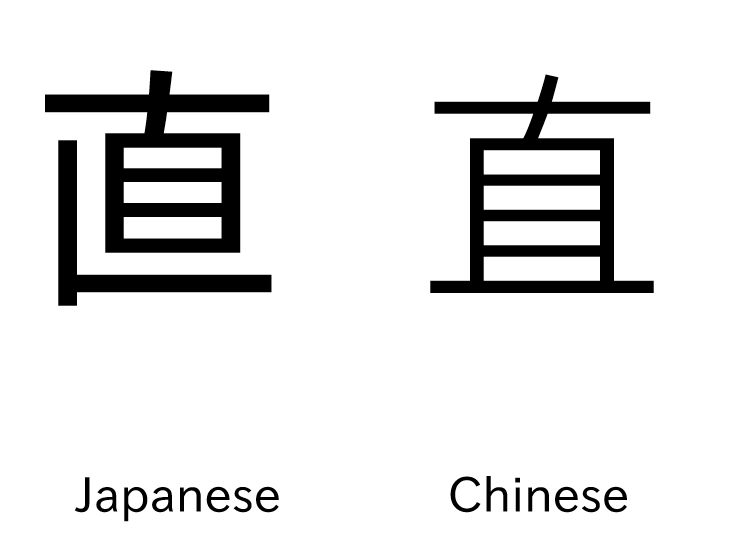
How does 直 display for you? Fix it here.
Additional Tools (optional read)¶
Get Yomichan. It is a browser extension that allows you to look up Japanese words on a page. You can read how to set it up here
For manga, I recommend KanjiTomo, it’s like Yomichan but for situations where you can’t select the text, e.g. in manga. It uses an OCR, so a little less reliable than Yomichan. To use, hover your mouse over whatever you want to look up.
Android tools¶
If you have an Android device, you can use Yomichan on Kiwi Browser.
You can get the app Rin which adds the iOS “Look Up” feature to your select menu.
There is also OCR Manga Reader which works a little like KanjiTomo.
You should get Typhon Reader, which works more like Yomichan. You can load .epub files into it, so it is the best way to read Japanese novels on your phone. There’s also Kaku, it’s a system wide OCR. Pretty useful too.
iOS tools¶
If you use an iOS device, you can use Books to read novels on your phone. You can use the “Look Up” feature. Make sure you have Japanese dictionaries enabled in Settings > General > Dictionary.
Kantan Manga Reader is the iOS equivalent of OCR Manga Reader.
Visual Novels
If you intend on playing Visual Novels, then make sure you setup texthooking, you can find out how to do that here
Discord¶
If you have any questions, you can ask at our Discord.
Sources¶
- YouTube - Stephen Krashen on Language Acquisition
- Stephen Krashen’s Theory of Second Language Acquisition
- Tae Kim - Japanese Grammar Guide
- Itazuraneko - main guide
- Input Hypothesis - Wikipedia

